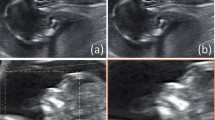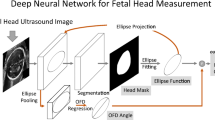Abstract
Nuchal translucency (NT) examination has become a standard item in early pregnancy tests because of its clinical value in detecting early gestational fetal abnormalities. Meanwhile, practitioners may sometimes have difficulty meeting the required criteria for NT measurement owing to their complexity or the exorbitant demand for NT tests. Thus, NT image quality control is critical, particularly for the frequently neglected criterion that the fetal head posture (FHP) shall be neither hyperextended nor hyperflexionated. The Nuchal Translucency Quality Review Program (NTQR) defines all FHPs quantitatively using the anterior-neck-lower-jaw angle (ANLJA), namely the angle between the fetal anterior neck and its lower jaw. According to NTQR’s definitions, hyperflexion is defined as ANLJA close to 0∘; hyperextension, ANLJA greater than 90∘; and normal FHP, ANLJA between 0∘ and 90∘. Focusing on FHP classification, we proposed a novel algorithm combining an attention mechanism and a convolutional neural network to predict ANLJAs. The new approach integrated channel and spatial attention and was capable of swiftly locating regions of interest. It abstracted important image features based on the information weight and attenuated useless information. The manual method was traditionally regarded as the gold standard for ANLJA measurement. Our findings indicated that the proposed algorithm performed admirably in the ANLJA prediction. It surpassed all other comparison algorithms in terms of efficiency.











Similar content being viewed by others
References
Amisha, Malik P, Pathania M, Rathaur VK (2019) Overview of artificial intelligence in medicine. J Family Med Prim Care 8(7):2328–2331. https://doi.org/10.4103/jfmpc.jfmpc_440_19
B R (2015) Fundamentals of Biostatistics, 8th edn Cengage Learning
Chang K, Bai HX, Zhou H, Su C, Bi WL, Agbodza E, Kavouridis VK, Senders JT, Boaro A, Beers A, Zhang B, Capellini A, Liao W, Shen Q, Li X, Xiao B, Cryan J, Ramkissoon S, Ramkissoon L, Ligon K, Wen PY, Bindra RS, Woo J, Arnaout O, Gerstner ER, Zhang PJ, Rosen BR, Yang L, Huang RY, Kalpathy-Cramer J (2018) Residual convolutional neural network for the determination of idh status in low- and high-grade gliomas from mr imaging. Clin Cancer Res 24(5):1073–1081. https://doi.org/10.1158/1078-0432.Ccr-17-2236
Chartrand G, Cheng PM, Vorontsov E, Drozdzal M, Turcotte S, Pal CJ, Kadoury S, Tang A (2017) Deep learning: A primer for radiologists. Radiographics 37(7):2113–2131. https://doi.org/10.1148/rg.2017170077
Choy G, Khalilzadeh O, Michalski M, Do S, Samir AE, Pianykh OS, Geis JR, Pandharipande PV, Brink JA, Dreyer KJ (2018) Current applications and future impact of machine learning in radiology. Radiology 288(2):318–328. https://doi.org/10.1148/radiol.2018171820
Dash JK, Mukhopadhyay S, Gupta RD, Khandelwal N (2021) Content-based image retrieval system for hrct lung images: assisting radiologists in self-learning and diagnosis of interstitial lung diseases. Multimedia Tools and Applications, pp 1–30. https://doi.org/10.1007/s11042-020-10173-4
Deng L (2014) Deep Learning: Methods and Applications. https://doi.org/10.1561/9781601988157
Dong S, Wang P, Abbas K (2021) A survey on deep learning and its applications. Comput Sci Rev 40(1):100379. https://doi.org/10.1016/j.cosrev.2021.100379
EK J (2018) Data-mining and analytics: rising concerns over privacy and people’s security. https://doi.org/10.33774/apsa-2019-fwthd-v3
Freeman WT, Pasztor EC (2000) Learning low-level vision. In: International conference on computer vision. https://doi.org/10.1109/ICCV.1999.790414
Hamet P, Tremblay J (2017) Artificial intelligence in medicine. Metabolism 69s:36–40. https://doi.org/10.1016/j.metabol.2017.01.011
Hu J, Shen L, Sun G (2018) Squeeze-and-excitation networks. In: Proceedings of the IEEE Conference on computer vision and pattern recognition, pp 7132–7141. https://doi.org/10.1109/TPAMI.2019.2913372
Jaderberg M, Simonyan K, Zisserman A (2015) Spatial transformer networks. Advances in neural information processing systems, p 28
Jain D, Kumar A, Garg G (2020) Sarcasm detection in mash-up language using soft-attention based bi-directional lstm and feature-rich cnn. Appl Soft Comput 91:106198. https://doi.org/10.1016/j.asoc.2020.106198
Kaul V, Enslin S, Gross SA (2020) History of artificial intelligence in medicine. Gastrointest Endosc 92(4):807–812. https://doi.org/10.1016/j.gie.2020.06.040
Kore S, Hegde A, Kanavia D, Supe P, Parikh M, Nandanwar YS (2013) Effects of period of gestation and position of fetal neck on nuchal translucency measurement. J Obstet Gynaecol India 63(4):244–8. https://doi.org/10.1007/s13224-012-0341-7
Lakshmi PS, Geetha M, Menon N, Krishnan V, Nedungadi P (2018). https://doi.org/10.1109/ICACCI.2018.8554914
LeCun Y, Bengio Y, Hinton G (2015) Deep learning. Nature 521(7553):436–44. https://doi.org/10.1038/nature14539
Litjens G, Kooi T, Bejnordi BE, Setio AAA, Ciompi F, Ghafoorian M, van der Laak J, van Ginneken B, Sánchez CI (2017) a survey on deep learning in medical image analysis. Med Image Anal 42:60–88. https://doi.org/10.1016/j.media.2017.07.005
Lockwood CJ, Moore T, Copel J (2020) https://www.ntqr.org/MyFTP/Documents/NTCriteria.pdf
Malone FD, D’Alton ME (2003) First-trimester sonographic screening for down syndrome. Obstet Gynecol 102(5 Pt 1):1066–79. https://doi.org/10.1016/j.obstetgynecol.2003.08.004
Maqueda AI, Loquercio A, Gallego G, Garcia N, Scaramuzza D (2018) Event-based vision meets deep learning on steering prediction for self-driving cars
Marini L, Tonetti MS, Nibali L, Rojas MA, Aimetti M, Cairo F, Cavalcanti R, Crea A, Ferrarotti F, Graziani F (2021) The staging and grading system in defining periodontitis cases: consistency and accuracy amongst periodontal experts, general dentists and undergraduate students. J Clin Periodontol 48(2):205–215. https://doi.org/10.1109/CVPR.2018.00568
Mnih V, Heess N, Graves A, Kavukcuoglu K (2014) Recurrent models of visual attention. Adv Neural Inf Process Syst, p 3
Nie S, Yu J, Chen P, Wang Y, Zhang JQ (2016) A hessian plate filter and shape feature-based approach to automatically localizing the nt voi of 3d ultrasound data. Comput Assist Surg 21(sup1):83–91. https://doi.org/10.1080/24699322.2016.1240317
Nie S, Yu J, Chen P, Wang Y, Zhang JQ (2017) Automatic detection of standard sagittal plane in the first trimester of pregnancy using 3-d ultrasound data. Ultrasound Med Biol 43(1):286–300. https://doi.org/10.1016/j.ultrasmedbio.2016.08.034
Nie S, Yu J, Wang Y, Zhang J, Chen P (2014) Shape model and marginal space of 3d ultrasound volume data for automatically detecting a fetal head. In: 2014 International conference on audio, language and image processing, pp 681–685. https://doi.org/10.1109/ICALIP.2014.7009881
Pandya PP, Kondylios A, Hilbert L, Snijders RJ, Nicolaides KH (1995) Chromosomal defects and outcome in 1015 fetuses with increased nuchal translucency. Ultrasound Obstet Gynecol 5(1):15–9. https://doi.org/10.1046/j.1469-0705.1995.05010015.x
Papadopoulos A, Korus P, Memon N (2021) Hard-attention for scalable image classification. Adv Neural Inf Process Syst, p 34
Peek N, Combi C, Marin R, Bellazzi R (2015) Thirty years of artificial intelligence in medicine (aime) conferences: a review of research themes. Artif Intell Med 65(1):61–73. https://doi.org/10.1016/j.artmed.2015.07.003
Peng Y, Zeng S, Luo Y (2021) Diagnosis and treatment for incarceration of retroverted uterus during pregnancy: a report of four cases. Chinese Journal of Perinatal Medicine 24 (02):141–146. https://doi.org/10.3760/cma.j.cn113903-20200524-00487
Peng Y, Huang B, Luo Y, Huang X, Yao L, Zeng S (2022) Cross-sectional reference values of cerebral ventricle for Chinese neonates born at 25-41 weeks of gestation. Eur J Pediatr 181(10):3645–3654. https://doi.org/10.1007/s00431-022-04547-z
Ramesh AN, Kambhampati C, Monson JR, Drew PJ (2004) Artificial intelligence in medicine. Ann R Coll Surg Engl 86(5):334–8. https://doi.org/10.1308/147870804290
Schlemper J, Oktay O, Chen L, Matthew J, Knight C, Kainz B, Glocker B, Rueckert D (2018) Attention-gated networks for improving ultrasound scan plane detection. arXiv:http://arxiv.org/abs/1804.05338
Shen J, Robertson N (2020) Bbas: Towards large scale effective ensemble adversarial attacks against deep neural network learning. Inf Sci 569:469–478. https://doi.org/10.1016/j.ins.2020.11.026
Siqing N, Jinhua Y, Ping C, Yuanyuan W, Yi G, Jian Qiu Z (2017) Automatic measurement of fetal nuchal translucency from three-dimensional ultrasound data. Annu Int Conf IEEE Eng Med Biol Soc 2017:3417–3420. https://doi.org/10.1109/embc.2017.8037590
Szegedy C, Wei L, Jia Y, Sermanet P, Rabinovich A (2015) Going deeper with convolutions. IEEE Computer Society. https://doi.org/10.1109/CVPR.2015.7298594
Thamizhvani TR, Ahmed K, Hemalatha RJ, Dhivya A, Chandrasekaran R (2021) Enhancement of mri images of hamstring avulsion injury using histogram based techniques. Multimedia Tools and Applications (3). https://doi.org/10.1007/s11042-020-10459-7
Wang Q, Wu B, Zhu P, Li P, Hu Q (2020 IEEE/CVF Conference on Computer Vision and Pattern Recognition (CVPR)) Eca-net: Efficient channel attention for deep convolutional neural networks
Wang L, Qian X, Zhang Y, Shen J, Cao X (2020) Enhancing sketch-based image retrieval by cnn semantic re-ranking. IEEE Trans Cybern 50 (7):3330–3342. https://doi.org/10.1109/TCYB.2019.2894498
Whitlow BJ, Chatzipapas IK, Economides DL (1998) The effect of fetal neck position on nuchal translucency measurement. Br J Obstet Gynaecol 105 (8):872–6. https://doi.org/10.1111/j.1471-0528.1998.tb10232.x
Xu K, Ba J, Kiros R, Cho K, Courville A, Salakhutdinov R, Zemel R, Bengio Y (2015) Show, attend and tell: Neural image caption generation with visual attention. Computer Science, pp 2048–2057
Yang X (2020) An overview of the attention mechanisms in computer vision. In: Journal of physics: Conference series, vol 1693, p 012173. IOP Publishing. https://doi.org/10.1088/1742-6596/1693/1/012173
Zhang Y, Li K, Li K, Wang L, Zhong B, Fu Y (2018) Image super-resolution using very deep residual channel attention networks. https://doi.org/10.1007/978-3-030-01234-2_18
Acknowledgements
A small part of the flowcharts were created by Biorender.com. We are grateful to Ms. Wenjuan Li and Ms. Yimin Liao for their contribution to this study.
Funding
This work is funded by the National Natural Science Foundation of China (under Grant No. 61772180), the Major Scientic and Technological Projects for collaborative prevention and control of birth defects in Hunan Province (No. 2019SK1010), the Science and Technology Innovation Projects of Hunan Province (No.2018SK50504), the Scientic Research Project of Hunan Provincial Commission (No.B202309026062 and B2019030), and the Natural Science Foundation of Hunan Province, China (Grant No. 2021JJ70008).
Author information
Authors and Affiliations
Corresponding author
Ethics declarations
Conflict of Interests
The authors have no relevant financial or non-financial interests to disclose.
Additional information
Publisher’s note
Springer Nature remains neutral with regard to jurisdictional claims in published maps and institutional affiliations.
Rights and permissions
Springer Nature or its licensor (e.g. a society or other partner) holds exclusive rights to this article under a publishing agreement with the author(s) or other rightsholder(s); author self-archiving of the accepted manuscript version of this article is solely governed by the terms of such publishing agreement and applicable law.
About this article
Cite this article
Peng, Yl., Zeng, S., Luo, Yc. et al. Attention mechanism optimized neural network for automatic measurement of fetal anterior-neck-lower-jaw angle in nuchal translucency tests. Multimed Tools Appl 83, 15629–15648 (2024). https://doi.org/10.1007/s11042-023-15491-x
Received:
Revised:
Accepted:
Published:
Issue Date:
DOI: https://doi.org/10.1007/s11042-023-15491-x




